|
|
|
Sort Order |
|
|
|
Items / Page
|
|
|
|
|
|
|
| Srl | Item |
| 1 |
ID:
191874
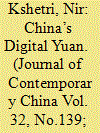

|
|
|
|
|
| Summary/Abstract |
This article highlights the key motivations behind China’s plan to launch the digital yuan and reviews the potential impacts on China and abroad. The article analyzes the digital yuan’s benefits to consumers, such as a reliable low-risk, low cost, and high-efficiency payment solution and the potential to promote financial inclusion. It compares the digital yuan with its most prominent competitors. Also discussed is how the digital yuan is expected to provide the Chinese Communist Party with a new powerful tool to monitor and control its economy and people. The article provides a critical evaluation of the potential of the digital yuan’s internationalization. This article also provides a perspective on the digital yuan to set global standards for the development of national digital currencies.
|
|
|
|
|
|
|
|
|
|
|
|
|
|
|
|
| 2 |
ID:
191876
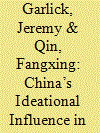

|
|
|
|
|
| Summary/Abstract |
Chinese and European scholarly debates on China’s relations with Central and Eastern Europe (CEE) have steadily heated up since the introduction of the 16/17 + 1 cooperation mechanism in 2012. However, they have tended to take place in discrete linguistic and academic bubbles. This article has three aims: first, to introduce Chinese scholarly debates on China-CEE cooperation to an Anglophone readership; second, to conduct a critical assessment of Chinese and European scholars’ inclusions and omissions; and third, to compare the narratives presented by Chinese scholars concerning China-CEE cooperation with European scholars’ interpretations. The content analysis demonstrates that Chinese scholars under-emphasize the influence-forming and ideational aspects of the platform, while European scholars insufficiently analyze the extent to which the 16/17 + 1ʹs characteristics are shared with other Chinese regional cooperation platforms.
|
|
|
|
|
|
|
|
|
|
|
|
|
|
|
|
| 3 |
ID:
191872
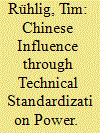

|
|
|
|
|
| Summary/Abstract |
Geo-economic rivalry is back on the international agenda, particularly in the field of high technology. Very often, technical standards are regarded as being a central arena of this competition. Surprisingly ignored is the question, how precisely technical standard-setting (such as Wi-Fi or 5G) empowers China. Based on the analysis of quantitative data, primary sources, and in-depth interviews, this article substantiates the widespread hypothesis that China’s growing footprint in technical standardization empowers the Chinese party-state. It introduces seven proxies to measure influence on standard-setting. Next, it explains how technical standards can be utilized by states to gain economic, legal, political, and discursive influence. Finally, it shows thatChina’s growing footprint in technical standardization is the result of party-state engagement, which provides leverage to China’s political leadership.
|
|
|
|
|
|
|
|
|
|
|
|
|
|
|
|
| 4 |
ID:
191869
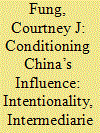

|
|
|
|
|
| Summary/Abstract |
According to popular accounts, China’s international influence is increasing with its growing material capabilities. However, researchers repeatedly demonstrate gaps between China’s power and its influence. Building on earlier research, we propose an inclusive approach to conceptualizing China’s influence abroad. Our approach conditions China’s net influence on three dimensions. First, intentionality distinguishes between intentional influence-seeking and influence that accrues unintentionally via influence externalities. Second, a systematic treatment of Chinese intermediaries–the diverse set of substate actors operating overseas–is needed in order to expand the study of Chinese influence beyond state-level behavior. Finally, domestic institutions in host countries are essential conduits for conditioning how the behavior of Chinese actors, as well as group and individual reactions within host countries, are aggregated up to the policy level.
|
|
|
|
|
|
|
|
|
|
|
|
|
|
|
|
| 5 |
ID:
191877


|
|
|
|
|
| Summary/Abstract |
Scholarly debates on Chinese foreign policy in the Middle East and the international dimension of authoritarianism have gained momentum since Beijing’s Belt and Road Initiative (BRI) in 2013. At the same time, the global pandemic provided a window of opportunity to autocrats worldwide to fine-tune their modes of surveillance for the sake of regime survival. This article deconstructs Sino-Emirati relations in the field of digital surveillance. Inspired by Social Network Theory, we explore three transregional public-private elite networks as multipliers for the traveling of authoritarian practices. We show that authoritarian diffusion under the umbrella of fighting the pandemic is not spatially bound to geographical proximity or other structural similarities but rather a global phenomenon that state and non-state actors reproduce.
|
|
|
|
|
|
|
|
|
|
|
|
|
|
|
|
| 6 |
ID:
191878


|
|
|
|
|
| Summary/Abstract |
China has made Yunnan Province its ‘Southern Gateway’ and the hub of its transportation corridors and energy-water nexus in Southeast Asia by incorporating the Greater Mekong Subregion into its ‘Belt and Road Initiative.’ China’s Lancang River (Upper Mekong) hydropower development generates costs and benefits for downstream countries. China dominates the Greater Mekong Subregion through institutional development, technological expertise, and financial investment; yet, despite asymmetrical power relationships, China’s Mekong neighbors guard their sovereignty and maintain substantial bargaining power. China is most successful when it embraces the ‘preferences’ it shares with them. An ongoing debate likewise undermines Beijing’s dominance among China’s stakeholders, who contest the developmental model versus the environmental sustainability model, as well as the meaning of ‘environmental protection.’
|
|
|
|
|
|
|
|
|
|
|
|
|
|
|
|
| 7 |
ID:
191871


|
|
|
|
|
| Summary/Abstract |
Despite a rise in Chinese public diplomacy efforts in the Philippines, Filipino perceptions of China have mainly remained negative during the Duterte period. This article examines why and how China’s public diplomacy efforts have primarily failed despite President Duterte’s pro-China position. It draws on constructivist approaches to demonstrate how national identity mediates the impact of Chinese influence. In particular, Chinese incursions in the West Philippine Sea, and an influx of China-based offshore gaming businesses in the country, have elicited a strong nationalist response from Filipinos, perpetuating perceptions of China as untrustworthy and threatening. Evidence is drawn to determine correlation between an increase in Chinese public diplomacy and a decrease in public trust towards China. This is followed by process-tracing how national identity dampens any positive effect Chinese public diplomacy may have on Philippine attitudes towards China.
|
|
|
|
|
|
|
|
|
|
|
|
|
|
|
|
| 8 |
ID:
191870


|
|
|
|
|
| Summary/Abstract |
This article traces the emergence of ‘Chinese influence’ as a conceptual touchstone of Australia’s public policy discourse in 2017–2018. The People’s Republic of China’s (PRC) efforts to influence politics abroad had been well documented since the 2000s and cannot explain the timing of their securitization from mid-2017. It was through the formation of a securitizing coalition of intelligence officials, politicians, and journalists that the PRC as a source of existential threats gained policy traction. But as the coalition expanded from security agencies to politicians and the media, the scope of the threat expanded from an initial concern with PRC party-state activity to the securitization of a much wider array of state and non-state activities under the ambiguous label ‘Chinese influence’.
|
|
|
|
|
|
|
|
|
|
|
|
|
|
|
|
| 9 |
ID:
191875
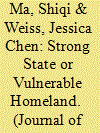

|
|
|
|
|
| Summary/Abstract |
Departing from its typical silence on pro-democracy movements around the world, Chinese state media encouraged a flood of reports about the 2019 Anti-Extradition Law Movement in Hong Kong . This article investigates two different media framing strategies to prevent democratic diffusion: demobilizing the masses by emphasizing state capacity and repression, and rallying the masses by emphasizing threats to national unity. Analyzing an original dataset of articles about the Hong Kong protests in the People’s Daily, this article documents a greater overall reliance on the rallying strategy, a tendency that became particularly pronounced in the later stage of the protest movement. Chinese media selectively reported events that would emphasize threats and downplayed stories about repression.
|
|
|
|
|
|
|
|
|
|
|
|
|
|
|
|
| 10 |
ID:
191873


|
|
|
|
|
| Summary/Abstract |
Xi Jinping has centralized foreign policymaking authorities by setting up new central coordination organizations with himself as the head to bypass entrenched interests and cut through bureaucratic roadblocks. Staking his claim to power on the party and demanding personal loyalty of Chinese bureaucrats to him in a way that none of his recent predecessors could; Xi has introduced a top-level design to develop strategic visions, conduct strategic planning, and make tough decisions. The top-level design has advanced the enlarged diplomacy far beyond the sphere of professional diplomats. But Xi’s personalization of Chinese foreign and security policymaking has increased the possibility of intended and unintended consequences of foreign adventure and actions.
|
|
|
|
|
|
|
|
|
|
|
|
|
|
|
|
|
|
|
|
|